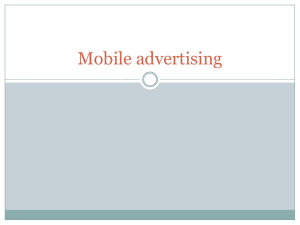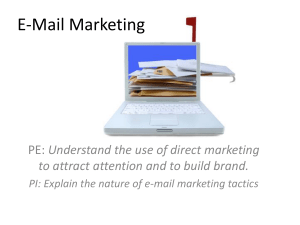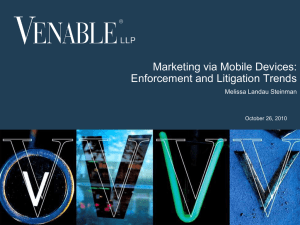Turning Online Strangers into Loyal Clients A Practical Guide to
advertisement
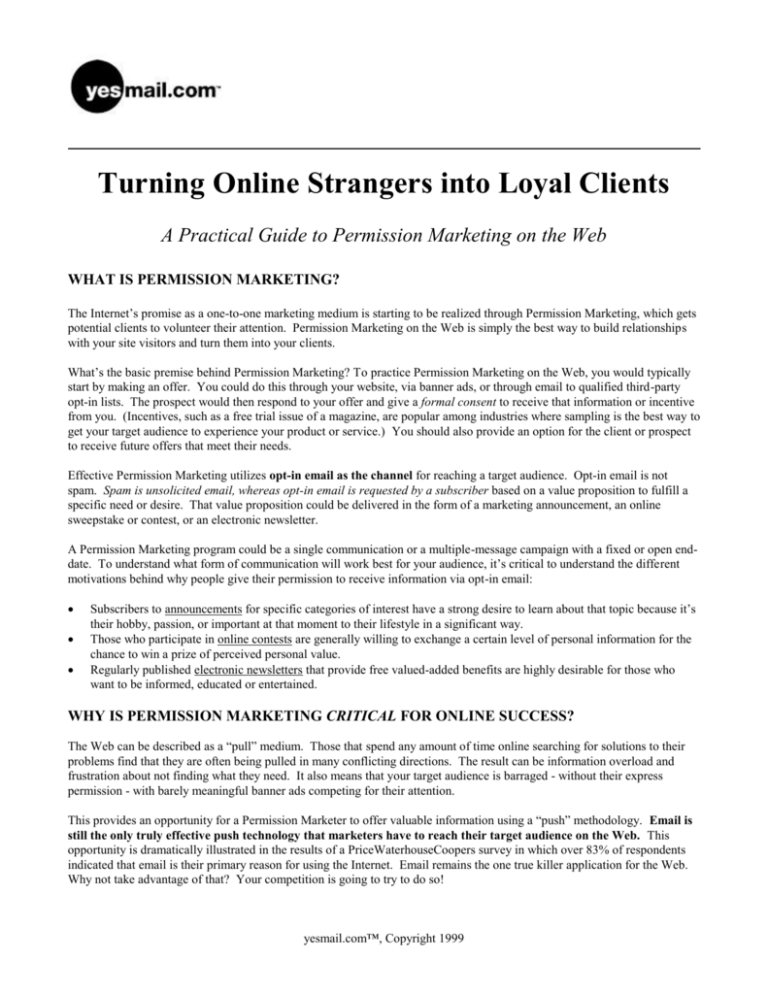
Turning Online Strangers into Loyal Clients A Practical Guide to Permission Marketing on the Web WHAT IS PERMISSION MARKETING? The Internet’s promise as a one-to-one marketing medium is starting to be realized through Permission Marketing, which gets potential clients to volunteer their attention. Permission Marketing on the Web is simply the best way to build relationships with your site visitors and turn them into your clients. What’s the basic premise behind Permission Marketing? To practice Permission Marketing on the Web, you would typically start by making an offer. You could do this through your website, via banner ads, or through email to qualified third-party opt-in lists. The prospect would then respond to your offer and give a formal consent to receive that information or incentive from you. (Incentives, such as a free trial issue of a magazine, are popular among industries where sampling is the best way to get your target audience to experience your product or service.) You should also provide an option for the client or prospect to receive future offers that meet their needs. Effective Permission Marketing utilizes opt-in email as the channel for reaching a target audience. Opt-in email is not spam. Spam is unsolicited email, whereas opt-in email is requested by a subscriber based on a value proposition to fulfill a specific need or desire. That value proposition could be delivered in the form of a marketing announcement, an online sweepstake or contest, or an electronic newsletter. A Permission Marketing program could be a single communication or a multiple-message campaign with a fixed or open enddate. To understand what form of communication will work best for your audience, it’s critical to understand the different motivations behind why people give their permission to receive information via opt-in email: Subscribers to announcements for specific categories of interest have a strong desire to learn about that topic because it’s their hobby, passion, or important at that moment to their lifestyle in a significant way. Those who participate in online contests are generally willing to exchange a certain level of personal information for the chance to win a prize of perceived personal value. Regularly published electronic newsletters that provide free valued-added benefits are highly desirable for those who want to be informed, educated or entertained. WHY IS PERMISSION MARKETING CRITICAL FOR ONLINE SUCCESS? The Web can be described as a “pull” medium. Those that spend any amount of time online searching for solutions to their problems find that they are often being pulled in many conflicting directions. The result can be information overload and frustration about not finding what they need. It also means that your target audience is barraged - without their express permission - with barely meaningful banner ads competing for their attention. This provides an opportunity for a Permission Marketer to offer valuable information using a “push” methodology. Email is still the only truly effective push technology that marketers have to reach their target audience on the Web. This opportunity is dramatically illustrated in the results of a PriceWaterhouseCoopers survey in which over 83% of respondents indicated that email is their primary reason for using the Internet. Email remains the one true killer application for the Web. Why not take advantage of that? Your competition is going to try to do so! yesmail.com™, Copyright 1999 In every major survey of online buyers, there are two consistent criteria for what motivates people to buy on the Web: brand awareness and discount pricing. Unless you’re already a household name or you can consistently provide the lowest prices in your market niche, you are going to have to create a unique value proposition to engage your target audience in a meaningful dialogue. The rule of thumb in traditional media is that it takes an average of seven messages or impressions to achieve response from your target audience. That means a single opt-in email message can’t realistically be a magic bullet. But a well-crafted multiple message opt-in email campaign, designed around the needs of your target audience, can help you achieve measurable and profitable results. Basically, Permission Marketers want the same thing their clients want: honest and well-designed marketing offers targeted only toward those who will appreciate and respond to them. HOW DO YOU INTEGRATE PERMISSION MARKETING INTO YOUR ONLINE EFFORTS? One of your online marketing goals might be to increase your client database and your client retention by a certain percentage. One criterion might be that you acquire relevant information from your clients so you will know them better and consequently be able to market to them better so they will remain loyal clients. Based on those goals and criteria, you would then develop your marketing strategies and the messages you want to communicate. In preparing your marketing plan, you must decide on your campaign objectives, targets, offers, various tests, and measures of campaign success. Let’s review these decisions that you’ll need to make: Establish Your Campaign Objectives - Many online marketers aim to secure an immediate purchase or transaction from prospects. The campaign’s success is judged by the response rate. In traditional direct mail marketing, a response rate of 2% is normally considered good. Yet this also implies that 98% of the campaign effort was wasted. The great news for Permission Marketers is that opt-in email response rates are much higher - ranging from 6% to 12% on average. Specially tailored offers to targeted opt-in email subscribers can achieve even higher results. Identify Your Target Audience - Permission Marketers need to figure out the characteristics of prospects who would be most able, willing, and ready to buy. In some industries, the best client targets are those who bought most recently, who buy frequently, and who spend the most. Good prospects can also be identified on the basis of such variables as age, sex, income, education, geographic location, etc. Occasions can also provide a good segmentation departure point. New mothers will be in the market for baby clothes and toys; college freshmen will buy computers and linens; and newly married couples will be looking for housing, furniture, appliances, bank loans, etc. Another segmentation departure point on the Web is consumer lifestyles. There are consumers who are computer buffs, gourmet cooks, outdoor enthusiasts, and so forth. Once the target market is defined, the Permission Marketer needs to obtain opt-in email addresses of prospects in the target market. Communicate Offers to Your Audience Regularly - Permission Marketers have to figure out an effective offer strategy to meet the target market’s needs. The campaign may consist of four elements: the product, the offer, the frequency of distribution, and the creative strategy. You must nurture the relationship and interact with the client via ongoing email informing and educating them on how your products or services can make their lives easier, more pleasant or more comfortable. Give your clients lots of information about your products or services to help them make their decisions. Go out of your way to nourish your clients. Give them the care they want. Immediately Test the Direct Marketing Elements - One of the wonderful advantages of Permission Marketing on the Web is the ability to test under real marketplace conditions the efficiency of different components of the offer strategy. Permission Marketers can test product features, copy, prices, various email list categories, and the like. Measure the Campaign’s Success and Evaluate How Well You’ve Done - By adding up the campaign’s planned costs, the Permission Marketer can figure out in advance the needed break-even response rate. By carefully analyzing past campaigns, Permission Marketers can steadily improve their performance. The ultimate value of a client is not revealed by the client’s purchase during a particular opt-in emailing. Rather, the client’s ultimate value is the profit made on all of the client’s purchases over time less the client acquisition and maintenance costs. How many clients are you interacting with regularly? Do you know who they are? Do you know what they want? How can you serve them better? yesmail.com™, Copyright 1999 WHAT ARE THE CRITERIA FOR PERMISSION MARKETING SUCCESS? Developing and sustaining relationships is an ongoing process. To determine your success, give yourself a report card and rate your company in each of these areas. We recommend you regularly evaluate your progress. Building Loyal and Trusting Client Relationships The huge opportunity of Permission Marketing is in client retention. As your clients become linked more closely to you and your company, you learn more about them and are able to serve them better. Are you making inroads forging and maintaining profitable, loyal, one-to-one relationships with your most valued clients? Has your repeat business increased? How are you nurturing your relationships with your clients? Are you using the appropriate Web strategies to build long-term relationships (e.g. opt-in email, online communities, electronic newsletters, and Web-based client support services)? As experienced marketers know, it’s a lot easier and less expensive to keep clients than it is to acquire new ones. Gathering Relevant Client Information Pertinent and useful client information is like gold. Have you acquired the information about your prospects or clients that you need to better serve them? Do you know your clients better now than before you started using Permission Marketing? Do you know who they are? What products do they like? What are their interests? If not, don’t be afraid to incorporate another innovative method of collecting information that’s different than the method you are now using. Focusing on Your Target Market Market focus helps you expand your web clientele. Are you achieving higher conversion rates because of better targeting to the audience? Do you have a database of opt-in email subscribers? What have you provided your clients to make them feel that they are benefiting from the relationship? What reason have you given them for wanting to continue to communicate with you? Leveraging Your Marketing Dollars By utilizing Permission Marketing, you get more “bang for the marketing buck” because you’re interacting with each client more efficiently. You can eliminate redundancies and utilize your marketing dollars more cost-effectively on a target audience who wants to hear from you. Have you been able to attract and retain more clients through Permission Marketing than with traditional direct mail? Have you improved profitability client by client by focusing on those who receive and return the best value? In what ways have you leveraged your marketing costs with this model? WHAT ARE CLIENT CONCERNS WHEN USING PERMISSION MARKETING? Permission Marketers and their clients usually enjoy mutually rewarding relationships. Occasionally, however, problems can arise if the Permission Marketer is insensitive to valid customer concerns: Simple excesses that irritate clients - Many people find an increasing number of hard-sell solicitations to be a nuisance. They will turn off to messages that are too frequent, too loud, too long, and too insistent. Cases of outright deception and fraud - Avoid designing email messages that may mislead potential buyers or that sound like fraudulent offers. Don’t exaggerate product size, performance claims, or the “retail price.” Invasion of privacy issues - When clients opt-in to your Permission Marketing program, they have the right to know how their private information will be used. That means not reselling or offering their information to another party without their express consent beforehand. yesmail.com™, Copyright 1999 HOW ARE COMPANIES SUCCESSFULLY USING PERMISSION MARKETING? Here are five real-world examples of what companies in major consumer and business-to-business industries are doing today that work to get new prospects and also nurture their clients: Travel Industry. A major airline uses opt-in email to alert its clients to last-minute fares that are priced at a special low rate for online purchase. This information gets to prospects and clients much quicker - and more cost-effective - than a newspaper or radio ad. The airline reaches its target audience more effectively and has a quicker turn-around time to fill the airplane seats vs. waiting till people respond to print or broadcast advertisements. Software Industry. A premier method of getting a prospect’s attention is offering free trial software via the Web. A leading software reseller that exists only in cyberspace and employs the Internet as its primary marketing channel has grown its database of clients exponentially by adapting this approach and by lowering the inherent overhead costs associated with a bricks-and-mortar store. Financial Services. Another effective means a leading financial institution utilized to attract new clients was offering special low-interest credit cards to a select demographic. Their response rate using qualified third-party opt-in email lists was a whopping 32%. This shows what can happen when you direct a great offer to the right target audience. Industrial Products. A European industrial company decided to test opt-in email to offer a print catalog to prospects in specific geographic areas throughout the European Union. The response rate was 10% higher than their past direct mail efforts. They calculated that they saved over $30,000 which they would have incurred using traditional direct mail and they would not have achieved such a high response rate. As a result, they could use the dollars they saved to do additional marketing to their target audience online. Medical Industry. A pharmaceutical corporation sends medical news updates monthly to its entire opt-in database of doctors and hospitals which includes current information about new drugs, their benefits, and their side effects. Providing value-added information is one of the surest ways to attract and maintain new clients through doctor referrals. An added benefit that the pharmaceutical company receives is a tremendous amount of feedback that helps them know their end-client better, what they are thinking and what other information doctors are interested in receiving . SUMMARY The nature of the Web lends itself to building one-to-one relationships through Permission Marketing. Unlike static brochures and printed sales materials, the Web provides a medium through which you can easily interact in real-time with prospects and clients. A well-executed Permission Marketing program can help turn your website visitors into online clients. Over time, those one-time customers can develop into loyal clients if you consistently identify what your clients want and notify them when you can meet those needs. By following the steps outlined in this guide, you can create a blueprint for your own Permission Marketing program on the Web. For additional tools to help create your own Permission Marketing program, you can go online to www.yesmail.com – or you can request a consultation with one of YesMail’s opt-in email experts by calling 1.877.7YESMAIL. ABOUT THE AUTHORS Deena Flammang is the co-founder of Net StrategEase, a marketing and business development consultancy that helps companies develop and execute Internet commerce initiatives. Deena has over 20 years’ experience in the marketing of software, hardware, and IT education products and services. She has held executive positions at major technology companies including Apple Computer, Honeywell, and GartnerGroup. Harvey John Morris, yesmail.com’s Director of Brand Marketing, is responsible for strategic brand and relationship marketing issues. Harvey has over 12 years of sales, marketing, and business development experience in the technology industry, including eight years of management experience at GartnerGroup. yesmail.com™, Copyright 1999
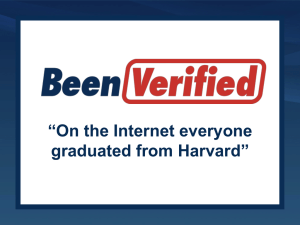
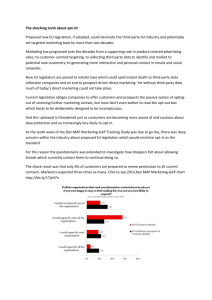
![[Download Accessible Version]15.55 KB](http://s3.studylib.net/store/data/006665349_1-345cee5afa892424cd84f5829eb18196-300x300.png)
